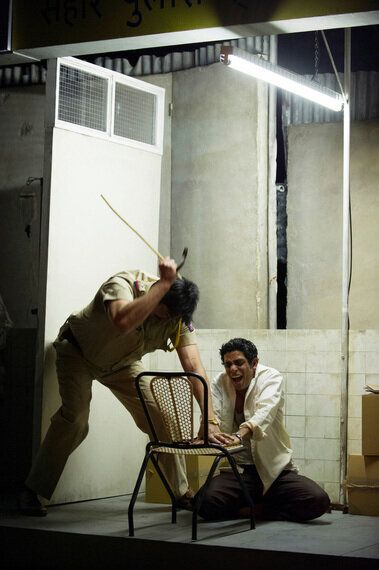
Inside Behind the Beautiful Forevers is a gripping epic tale of life and loss in the Mumbai slums just dying to burst free. All the ingredients are there in this evocative blend of sights, sounds and voices but at times it feels as if there's just too many of them.
Based on the best-selling book by Katherine Boo, Behind the Beautiful Forevers is a dynamic, vibrant depiction of the dark side of India's rapid economic success. For under the Mumbai flight-path lies a vast slum that teems with people desperate to grab some of India's riches for themselves - by any means possible.
The way Director Rufus Norris has recreated the Mumbai slums on the Olivier stage is almost breath-taking. The energy and the tumbling chaos of this world is quite something to behold.
Low-flying aircraft scream overhead, rivers of tossed away plastic bottles pour onto the stage like waterfalls and the flimsy shanty town shacks that are built as easily by the residents as quickly as they are demolished by the state fill the stage.

All of the design team deserve credit for this achievement (led by designer: Katrina Lindsay). The production budget must have been eye-watering but the result is a resounding success.
And the show just sizzles with energy, whether it's from the banging bursts of Bhangra music, the vast billboards that loom overhead revolving through their advertisements, or in the stage that positively teems with life.
There's much to be said for the chaotic way the play depicts the swirling interdependency of lives below the poverty line. The sense of characters living on top of each other in the heaving, sweaty slums is palpable. However this does have consequences in trying to grab a clear storyline to hook us.
Adapted by David Hare, the play has taken a calculated risk in not identifying a single main character to pivot and plot the play around. There are characters we get to know, such as Meera Syal's steely matriarch who binds her Muslim family together against the prejudice and jealousy from others as she pushes to enrich their lives.

Then there's her son, a principled young man trying desperately to find some honourable way out of poverty. Only what's the point in having principles when the corruption around you is so endemic?
There's light relief to be found in their sharp-tongued disabled neighbour who earns the cash as a prostitute whilst her husband is away and her kids are out scrounging a living. And then there is the crafty go-to woman who will cut you a deal with the corrupt authorities - the police and the courts - but that help will come at a price.
The play confronts the injustice of life in the slums head on but also tackles globalisation - a stock market crash in Wall Street may cause a banker to lose his job in New York but the trickle-down effect in Mumbai is that the value of the recycled bottles crash and so a family starves.
The theme I most warmed to though was the challenge of this dynamic change on traditional Indian culture and custom.

The most bittersweet storyline was that of the two young girls having secret rendezvous in the dirty communal toilets just so they can teach each other English, to educate themselves out of their dreadful lives. Their secrecy is necessary as educating girls is abhorrent in their families, their parents seeing the girls' value only in their domestic servitude and there are tragic consequences when they are discovered.
I could keep going on... There really are so many characters. It's enriching in many ways - you see so much, we learn so much - but too often some of these storylines drag and the three hour running time weighs heavy. If only 20 minutes had been trimmed and some of the story lines streamlined, this play would have had the right balance between the optimistic energy and the required pathos.
I am excited that we have a big production that isn't about white middle-class England. But I find that mitigated somewhat when that voice, that representation, has been compromised as the play is still written and directed by white middle-class men.
The play was adapted by David Hare, a writer of great repute but, much like when the National hired a man (Nick Payne) to write a play about feminism (Blurred Lines) I can't help but be a little frustrated with the choice of a white man to write a play about India, and in particular, Indian women who make up the vast majority of the principal characters on show.
Behind the Beautiful Forevers is an exciting production. There are flaws, yes, but it is important that theatre continues to take risks so I am more forgiving of the challenges in the production than perhaps others will be. But next time can we also have as much breakthrough in the creative team as well as the story being told? Thanks.
National Theatre, London to April 13, 2015
Image Credits:
1. A scene from Behind the Beautiful Forevers - image by Richard Hubert Smith
2. Meera Syal - Zehrunisa Husain, Bharti Patel - Laxmi Chinu Behind the Beautiful Forevers image by Richard Hubert Smith
3. Chook Sibtain - Sub-Inspector Shankar Yeram, Shane Zaza - Abdul Husain Behind the Beautiful Forevers image by Richard Hubert Smith
4. Anjana Vasan - Manju Waghekar, Annika Rose - Meena Chinnu Behind the Beautiful Forevers image by Richard Hubert Smith